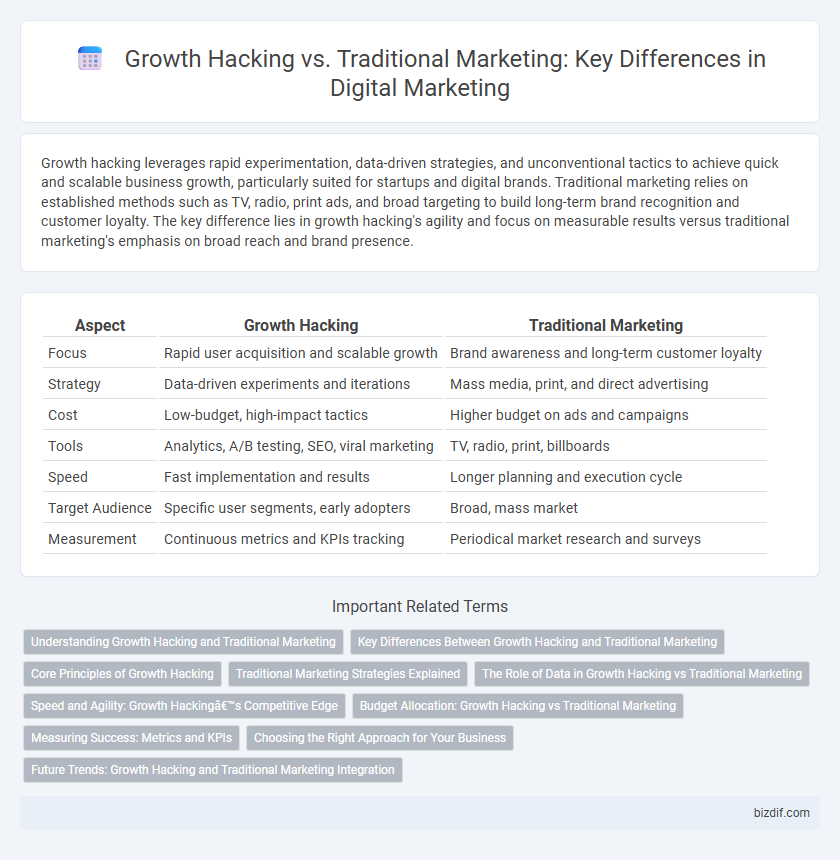Growth hacking leverages rapid experimentation, data-driven strategies, and unconventional tactics to achieve quick and scalable business growth, particularly suited for startups and digital brands. Traditional marketing relies on established methods such as TV, radio, print ads, and broad targeting to build long-term brand recognition and customer loyalty. The key difference lies in growth hacking's agility and focus on measurable results versus traditional marketing's emphasis on broad reach and brand presence.
Table of Comparison
| Aspect | Growth Hacking | Traditional Marketing |
|---|---|---|
| Focus | Rapid user acquisition and scalable growth | Brand awareness and long-term customer loyalty |
| Strategy | Data-driven experiments and iterations | Mass media, print, and direct advertising |
| Cost | Low-budget, high-impact tactics | Higher budget on ads and campaigns |
| Tools | Analytics, A/B testing, SEO, viral marketing | TV, radio, print, billboards |
| Speed | Fast implementation and results | Longer planning and execution cycle |
| Target Audience | Specific user segments, early adopters | Broad, mass market |
| Measurement | Continuous metrics and KPIs tracking | Periodical market research and surveys |
Understanding Growth Hacking and Traditional Marketing
Growth hacking leverages data-driven strategies, rapid experimentation, and digital tools to accelerate user acquisition and optimize marketing ROI, prioritizing scalable growth over brand building. Traditional marketing relies on established channels like print, TV, and radio, focusing on long-term brand awareness and customer loyalty through broad messaging. Understanding growth hacking involves analyzing user behavior and leveraging technology for quick iterations, whereas traditional marketing emphasizes consistent brand messaging and mass market reach.
Key Differences Between Growth Hacking and Traditional Marketing
Growth hacking prioritizes rapid experimentation across digital channels to identify the most effective and scalable marketing strategies, leveraging data analytics and automation tools. Traditional marketing relies on established channels like TV, print, and radio, emphasizing long-term brand building and broad audience reach through fixed budgets. The key difference lies in growth hacking's agile, metric-driven approach compared to traditional marketing's structured, campaign-focused methodology.
Core Principles of Growth Hacking
Growth hacking centers on rapid experimentation, data-driven decisions, and scalable techniques to achieve accelerated user acquisition and retention, contrasting traditional marketing's slower, campaign-focused methods. Core principles include leveraging analytics to identify growth opportunities, employing creativity to optimize conversion rates, and adopting cross-functional collaboration to iterate strategies quickly. This approach emphasizes continuous testing and agility, enabling startups and businesses to maximize growth with limited resources.
Traditional Marketing Strategies Explained
Traditional marketing strategies rely on well-established channels like television, radio, print media, and direct mail to reach a broad audience with targeted messaging. These techniques emphasize brand awareness through consistent, carefully crafted campaigns designed for mass consumption over time. The focus remains on building long-term brand equity and customer loyalty through repetitive exposure and trusted media outlets.
The Role of Data in Growth Hacking vs Traditional Marketing
Growth hacking leverages real-time data analytics and A/B testing to optimize campaigns rapidly, enabling targeted, data-driven decision-making for maximizing user acquisition and retention. Traditional marketing often relies on broader market research and historical data, which can delay adjustments and limit personalization. The role of data in growth hacking is central and continuous, whereas in traditional marketing, data serves more as a periodic reference point rather than a dynamic tool for ongoing optimization.
Speed and Agility: Growth Hacking’s Competitive Edge
Growth hacking leverages rapid experimentation and real-time data analysis to accelerate campaign performance far beyond the slower, conventional cycles of traditional marketing. Its agility allows marketers to swiftly adapt strategies based on user behavior and market trends, significantly reducing time-to-market for new ideas. This speed and flexibility provide a competitive edge in fast-paced digital environments, enabling brands to optimize growth opportunities with precision and efficiency.
Budget Allocation: Growth Hacking vs Traditional Marketing
Growth hacking allocates budget primarily towards low-cost, high-impact tactics such as social media campaigns, viral content creation, and data-driven experiments, maximizing ROI with minimal spend. Traditional marketing relies heavily on larger investments in mass media advertising, print, and broadcast channels, often resulting in higher upfront costs. The agile budget approach in growth hacking enables rapid testing and optimization, contrasting with the fixed and substantial budget commitments seen in traditional marketing strategies.
Measuring Success: Metrics and KPIs
Growth hacking emphasizes data-driven metrics such as customer acquisition cost (CAC), viral coefficient, and activation rate to measure success rapidly and efficiently. Traditional marketing often relies on broader KPIs like brand awareness, market share, and ROI over longer periods to gauge campaign impact. Analyzing real-time performance metrics allows growth hackers to iterate strategies quickly, while traditional marketing focuses on sustained brand positioning and long-term customer engagement.
Choosing the Right Approach for Your Business
Growth hacking leverages data-driven experiments and rapid testing to accelerate startup growth with minimal budgets, making it ideal for businesses seeking quick scalability and innovation. Traditional marketing employs established strategies like TV, print, and brand-focused campaigns to build long-term customer loyalty and market presence, suited for companies with larger budgets and stable growth goals. Choosing the right approach depends on your business size, target audience behavior, budget constraints, and growth timeline, allowing for tailored marketing tactics that maximize ROI and market impact.
Future Trends: Growth Hacking and Traditional Marketing Integration
Growth hacking and traditional marketing are converging as businesses leverage data analytics, AI, and automation to enhance campaign effectiveness and ROI. Future trends indicate a seamless integration where growth hacking's rapid experimentation complements traditional marketing's brand-building strategies. This hybrid approach drives personalized customer experiences and scalable growth in the evolving digital landscape.
Growth Hacking vs Traditional Marketing Infographic

 bizdif.com
bizdif.com